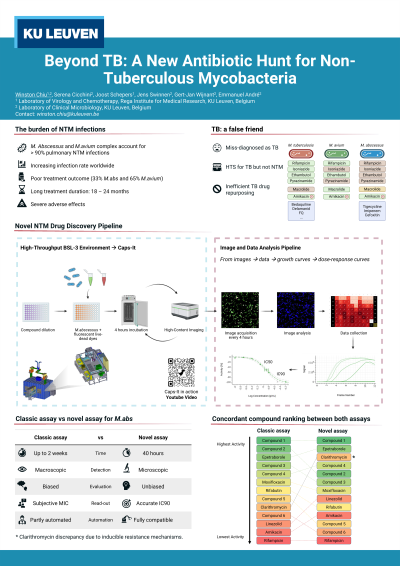Screening Applications & Diagnostics
Poster Session A
(1018-A) A novel, high-content imaging-based phenotypic screening assay to advance drug discovery for nontuberculous mycobacteria
Tuesday, May 28, 2024
16:30 - 17:15 CEST
Location: Exhibit Hall


Winston Chiu (he/him/his)
PhD student - Caps-It
KU Leuven
Leuven, Vlaams-Brabant, Belgium
Poster Presenter(s)
Abstract: Among the pathogenic nontuberculous mycobacteria (NTM), Mycobacteroïdes abscessus is an emerging pathogen carrying an alarming ability to develop drug resistance. Due to the poor treatment outcomes of current antibiotics, the treatment of NTM infections remains a major challenge. Therefore, we urgently need to develop new antibiotics that enable more effective, shorter and safer treatment regiments for NTM infections. In this proof-of-concept study, we developed a new, high content imaging-based drug screening assay and compared the outcomes with the MIC results of the “gold standard” broth microdilution assay for a panel of 15 known and new compounds.
We developed a novel phenotypic drug discovery approach based on high-content imaging using fluorescent microscopy to monitor bacterial growth and death kinetics over time in 96-well plates. This assay currently uses the M. abscessus subsp. abscessus ATCC 19977 strain and can be run fully automated in the BSL-3 “Caps-It” isolator system. Following incubation of bacteria with various drug concentrations for 40 hours, the area under the bacterial growth curves was determined and 90% inhibitory concentrations (IC90) calculated based on the resulting dose-response curves. We tested 15 compounds using this approach and compared it with the classic broth dilution method. No major discrepancies were observed between the two methods except for clarithromycin. The compounds with the lowest MIC were concordant with the compounds with the lowest IC90.
Our novel imaging-based assay allows high-throughput screening of NTMs against novel compound libraries. Here we showed comparable results with the standard MIC testing while being automation compatible and providing more accurate data in function of time. These encouraging results, which are to be consolidated in a larger comparative study, could ultimately position our imaging approach as a new validated method for NTM drug discovery.
We developed a novel phenotypic drug discovery approach based on high-content imaging using fluorescent microscopy to monitor bacterial growth and death kinetics over time in 96-well plates. This assay currently uses the M. abscessus subsp. abscessus ATCC 19977 strain and can be run fully automated in the BSL-3 “Caps-It” isolator system. Following incubation of bacteria with various drug concentrations for 40 hours, the area under the bacterial growth curves was determined and 90% inhibitory concentrations (IC90) calculated based on the resulting dose-response curves. We tested 15 compounds using this approach and compared it with the classic broth dilution method. No major discrepancies were observed between the two methods except for clarithromycin. The compounds with the lowest MIC were concordant with the compounds with the lowest IC90.
Our novel imaging-based assay allows high-throughput screening of NTMs against novel compound libraries. Here we showed comparable results with the standard MIC testing while being automation compatible and providing more accurate data in function of time. These encouraging results, which are to be consolidated in a larger comparative study, could ultimately position our imaging approach as a new validated method for NTM drug discovery.
